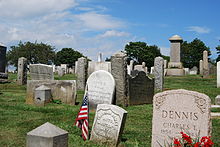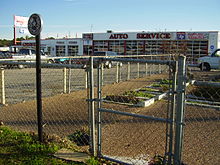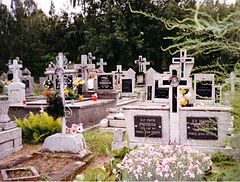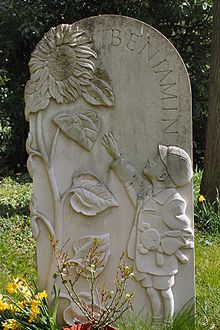- Cemetery
-
For other uses, see Cemetery (disambiguation).A cemetery in Kyoto, Japan

 Royal Burial Ground, Frogmore, England
Royal Burial Ground, Frogmore, England
A cemetery is a place in which dead bodies and cremated remains are buried. The term "cemetery" (from Greek κοιμητήριον: sleeping place) implies that the land is specifically designated as a burying ground. Cemeteries in the Western world are where the final ceremonies of death are observed. These ceremonies or rites differ according to cultural practice and religious belief.
Definition
The Oxford English Dictionary defines a cemetery as a "burial-ground generally; now esp. a large public park or ground laid out expressly for the interment of the dead, and not being the ‘yard’ of any church. (Cemetery c)" and specifies that the term "...originally applied to the Roman underground cemeteries or catacombs "[1] Cemeteries are normally distinct from churchyards, which are typically consecrated according to one denomination and are attached directly to a single place of worship.
Cemeteries through history
Archaeology
Main article: Grave fieldFurther information: tomb, necropolis, and Funerary artPrehistoric cemeteries are sometimes referred to by the term 'grave field'. They are one of the chief sources of information on ancient and prehistoric cultures, and numerous archaeological cultures are defined by their burial customs, such as the Urnfield culture of the European Bronze Age.
Early Christian history
From about the 7th century, European burial was under the control of the Church and could only take place on consecrated church ground. Practices varied, but in continental Europe, bodies were usually buried in a mass grave until they had decomposed. The bones were then exhumed and stored in ossuaries, either along the arcaded bounding walls of the cemetery, or within the church under floor slabs and behind walls.
In most cultures those who were vastly rich, had important professions, were part of the nobility or were of any other high social status were usually buried in individual crypts inside or beneath the relevant place of worship with an indication of the name of the deceased, date of death and other biographical data. In Europe this was often accompanied with a depiction of their coat of arms.
Most others were buried in graveyards again divided by social status. Families of the deceased who could afford the work of a stonemason had a headstone carved and set up over the place of burial with an indication of the name of the deceased, date of death and sometimes other biographical data. Usually, the more writing and symbols carved on the headstone, the more expensive it was. As with most other human property such as houses and means of transport, richer families used to compete for the artistic value of their family headstone in comparison to others around it, sometimes adding a statue (such as a weeping angel) on the top of the grave.
Those who could not pay for a headstone at all usually had some religious symbol made from wood on the place of burial such as a Christian cross; however, this would quickly deteriorate under the rain or snow. Some families hired a blacksmith and had large crosses made from various metals put on the place of burial.
Graveyards replaced by cemeteries
Main article: GraveyardVarious conditions in the late 18th century and throughout the 19th century led to the burial of the dead in graveyards being discontinued. Among the reasons for this were:
- A very sharp rise in the size of the population during the early stages of the Industrial Revolution
- Continued outbreaks of highly infectious diseases in towns and cities due to lack of public hygiene. Many graveyards in cities were located on land enclosed within the city walls.
- Limits to, and lack of, space in graveyards for new headstones and corpses.
- A growing resistance in existing churches to bury dead who had never attended their church despite being legally obliged to do so for any "parishioner".
As a consequence of these reasons, city authorities, national governments and places of worship all changed their regulations for burials. In many European states, burial in graveyards was outlawed altogether either by royal decrees or government legislation.
In some cases, skeletons were exhumed from graveyards and moved into ossuaries or catacombs. A large action of this type occurred in 18th century Paris when human remains were transferred from graveyards all over the city to the Catacombs of Paris. The bones of an estimated 6 million people are to be found there.[2]
However, in most places across Europe (as well as in larger cities in North America) completely new places of burial were established away from heavily populated areas and outside of old towns and city centers. Many new cemeteries became municipally owned or were run by their own corporations, and thus independent from churches and their churchyards. Nevertheless, even these were still segregated by the faith of the deceased to be buried there.
Thus, cemeteries (certainly in their modern landscaped or garden cemetery form), rather than graveyards, became the principal place of burial for the deceased and continue to this day. Wadi-us-Salaam, located in Shiite holy city of Najaf, Iraq, is reputed to be the largest cemetery in the world.[3] It is estimated more than half a million corpses are interred in the cemetery each year.[4]
Modern cemeteries
The town cemetery on the plains of Calhan, Colorado.The 1,400 square feet (130 m2) plot pictured here has the graves of nineteen members of the Hillendahl family, including one who was interred in 1854, in the Spring Branch area of Houston, Texas, United States. A descendant of the family sold all of the land around the grave site, but refused to move the actual graves.[5]
The earliest of the spacious landscaped-style cemeteries is Père Lachaise in Paris. This embodied the idea of state- rather than church-controlled burial – a concept that spread through Europe with the Napoleonic invasions, and sometimes became adapted leading to the opening of cemeteries by private companies. The shift to municipal cemeteries or those established by private companies was usually accompanied by the establishing of spacious, landscaped, burial grounds outside of the city limits.
Cemeteries are usually a respected or protected area, and often include a crematorium for the cremation of the dead. The violation of the graves or buildings is usually considered a very serious crime, and punishments are often severe.
The style of cemeteries varies greatly internationally. For example, in the United States and many European countries, modern cemeteries usually have many tombstones placed on open spaces. In Russia, tombstones are usually placed in small fenced family lots. (This was once common practice in American cemeteries as well, and such fenced family plots are still visible in some older American cemeteries.)
Usually, there is a legal requirement to maintain records regarding the burials (or interment of ashes) within a cemetery. These burial registers usually contain (at a minimum) the name of the person buried, the date of burial and the location of the burial within the cemetery, although some burial registers contain far more information about the deceased person. Burial registers are an important resource for genealogy.
In order to physically manage the space within the cemetery (to avoid burials in existing graves) and to record locations in the burial register, most cemeteries have some systematic layout of graves in rows, generally grouped into larger sections as required. Often the cemetery displays this information in the form of a map, which is used both by the cemetery administration in managing their land use and also by friends and family members seeking to locate a particular grave within the cemetery.
Traditionally cemetery management only involves the allocation of land for burial, the digging and filling of graves, and the maintenance of the grounds and landscaping. The construction and maintenance of headstones and other grave monuments is usually the private responsibility of families of the deceased. However, increasingly, many people regard the resultant collection of individual headstones, concrete slabs and fences (some of which may be decayed or damaged) to be aesthetically unappealing, leading to new cemetery developments either standardising the shape or design of headstones or plaques, sometimes by providing a standard shaped marker as part of the service provided by the cemetery. This has led to the development of new styles of cemetery.
Contemporary styles of cemetery
There are a number of different styles of cemetery in use. Many cemeteries have areas based on different styles, reflecting the diversity of cultural practices around death and how it changes over time.
Monumental cemetery
Monument of c. 1910 in the Monumental Cemetery of Staglieno in Genoa, Italy, one of the most spectacular of a number of Italian cemeteries featuring large-scale sculpture.
A monumental cemetery is the traditional style of cemetery where headstones or other monuments made of marble, granite or similar materials rise vertically above the ground (typically around 50 cm but some can be over 2 metres high). Often the entire grave is covered by a slab, commonly concrete, but it can be more expensive materials such as marble or granite, and/or has its boundaries delimited by a fence which may be made of concrete, cast iron or timber. Where a number of family members are buried together (either vertically or horizontally), the slab or boundaries may encompass a number of graves. Monumental cemeteries are often regarded as unsightly due to the random collection of monuments and headstones they contain. Also, as maintenance of the headstones is the responsibility of family members, over time many headstones are forgotten about and decay and become damaged. For cemetery authorities, monumental cemeteries are difficult to maintain. While cemeteries often have grassed areas between graves, the layout of graves makes it difficult to use modern equipment such as ride-on lawn mowers in the cemetery. Often the maintenance of grass must be done by more labour-intensive (and therefore expensive) methods. In order to reduce the labour cost, devices such as whipper-snippers are increasingly used in cemetery maintenance,[citation needed] but such devices can damage the monuments and headstones. Cemetery authorities dislike the criticism they receive for the deteriorating condition of the headstones, arguing that they have no responsibility for the upkeep of headstones, and typically disregard their own maintenance practices as being one of the causes of that deterioration.[citation needed]
Lawn cemetery
A lawn cemetery (as the name suggests) is covered in grass. Each grave is marked with a commemorative plaque (around 30 cm x 20 cm is typical) placed horizontally at the head of the grave at ground-level. While families are normally still involved in the design and information contained on the plaque, generally the size and materials of the plaque are constrained by the cemetery authorities, who often strongly encourage (or in some cases mandate) the use of a standard design.
Typically, lawn cemeteries comprise a number of graves in this lawn setting with trees and gardens on the perimeter. While aesthetic appeal to family members has been the primary driver for the development of lawn cemeteries, cemetery authorities were initially very enthusiastic about this new style of cemetery, as they appeared to be easier to maintain. By initially selecting (or grading) the land intended for a lawn cemetery to be completely flat, it allows the use of large efficient mowers (such as ride-on mowers or lawn tractors) to be used as the plaques (being horizontally set in the ground) lie below the level of the blades and are not damaged by the blades. Unfortunately, in practice, while families are often initially attracted to the uncluttered appearance of a lawn cemetery, the common practice of placing flowers (sometimes in vases) and increasingly other items (e.g. small toys on children's graves) re-introduces some clutter to the cemetery and makes it difficult to use the larger mowers. While cemetery authorities increasingly impose restrictions on the nature and type of objects that can be placed on lawn graves and actively remove prohibited items, grieving families are often unwilling to comply with these restrictions and become very upset if the items are removed. Another problem with lawn cemeteries is that over time the grass can grow over and cover the plaque to the distress of families who can no longer easily locate the grave. Grasses that propagate by an above-ground stolon (aka runner) can cover a plaque very quickly. Grasses that propagate by a below-ground rhizome tend not to cover the plaque as easily.
A lawn beam cemetery is a recent development which seeks to solve the problems of the lawn cemetery while retaining many of its benefits. Low (10–15 cm) raised concrete slabs (beams) are placed across the cemetery. Commemorative plaques (usually standardised in terms of size and materials similar to lawn cemeteries) are placed on these beams adjacent to each grave. The graves themselves are covered with grass like a lawn cemetery. The areas between the beams are large enough that they are easy to mow with a larger mower. As the mower blades are set lower than the top of the beam and the mowers do not go over the beam, the blades cannot damage the plaques. Up on the beam, the plaques cannot be easily overgrown by grass and there is space between the plaques for families to place flowers and other objects without interfering with the mowing.
Natural cemeteries
A natural cemetery or eco-cemetery or green cemetery is a new style of cemetery and is an area set aside for natural burials (with or without coffins). Natural burials are motivated by a desire to be environmentally conscious with the body rapidly decomposing and becoming part of the natural environment without incurring the environmental cost of traditional burials. Although in principle natural burial can be performed in any style of cemetery, typically the environmental motivations of those requesting natural burial tend to favor the use of a natural bushland or woodland setting for the natural burial. Because of the number of trees usually present in a natural cemetery, burials occur in whatever location and orientation best fits the natural environment as opposed to the more traditional rows or other orderly arrangements in traditional cemeteries. As a consequence, natural burial may actually be less efficient land-use than a traditional cemetery. However, because of the rapid decomposition of a natural burial, in principle the re-use of the grave site can occur earlier than in other conventional burials, which would improve the efficiency of land use. However, it remains to be seen if family members will accept the early re-use of natural burial sites, given the general community dislike of re-use of any kind of grave. Another consequence of the lack of orderly burials is the need for highly accurate surveying of the grave site for effective cemetery management, to prevent the accidental re-use of a grave site.
In keeping with the intention of "returning to nature" and the early re-use potential, natural cemeteries do not normally have conventional grave markings such as headstones. Instead, the planting of a tree or bush or placement of a rock is regarded as the more appropriate way to commemorate the deceased. However, as with other types of cemetery, the intentions of the cemetery authorities may be in conflict with the grieving practices of family and friends, for whom being able to visit the precise location of a grave and see the name of the deceased is often important. In some natural cemeteries, names can be inscribed on naturally-shaped rocks (not carved headstones) but, unless the rock is particularly large and heavy, it can easily be knocked or kicked to another nearby location.
Columbarium wall
A columbarium wall at Lawnton, Queensland, showing empty niches, plaques and flower holders
Columbarium walls are a common feature of many cemeteries, reflecting the increasing use of cremation rather than burial. While cremated remains can be kept at home by families in urns or scattered in some significant or attractive place, neither of these approaches allows for a long-lasting commemorative plaque to honour the deceased nor provides a place for the wider circle of friends and family to come to mourn or "pay their respects" (the practice of honouring a deceased person by visiting their grave). Therefore, many cemeteries now provide walls (typically of brick or rendered brick construction) with a rectangular array of niches, with each niche being big enough to accommodate a person's cremated remains. Columbarium walls are a very space-efficient use of land in a cemetery compared with burials and a niche in a columbarium wall is a much cheaper alternative to a burial plot. A small plaque (about 15 cm x 10 cm) can be affixed across the front of each niche and is generally included as part of the price of a niche. As the writing on the plaques has to be fairly small to fit on the small size of the plaque, the design of columbarium walls is constrained by the ability of visitors to read the plaques. Thus, the niches are typically placed between 1 metre to 2 metres above the ground so the plaques can be easily read by an adult. Some columbarium walls have niches going close to ground level, but these niches are usually unpopular with families as it is difficult to read the plaque without bending down very low (something older people in particular find difficult or uncomfortable to do).
As with graves, the niches may be assigned by the cemetery authorities or families may choose from the unoccupied niches available. It is usually possible to purchase (or pay a deposit) to reserve the use of adjacent niches for other family members. The use of adjacent niches (vertically or horizontally) usually permits a larger plaque spanning all the niches involved, which provides more space for the writing. As with graves, there may be separate columbarium walls for different religions or for war veterans. As with lawn cemeteries, the original expectation was that people would prefer the uncluttered simplicity of a wall of plaques, but the practice of leaving flowers is very entrenched. Mourners leave flowers (and other objects) on top of columbarium walls or at the base, as close as they can to the plaque of their family member. In some cases, it is possible to squeeze a piece of wire or string under the plaque allowing a flower or small posy to be placed on the plaque itself or clips are glued onto the plaque for that purpose. Newer designs of columbarium walls take this desire to leave flowers into account by incorporating a metal clip or loop beside each plaque, typically designed to hold a single flower stem or a small posy. As the flowers decay, they simply fall to the ground and do not create a significant maintenance problem.
Family cemeteries
 Holland Cemetery: A rural cemetery in northeast Oklahoma
Holland Cemetery: A rural cemetery in northeast Oklahoma
While uncommon today, family (or private) cemeteries were a matter of practicality during the settlement of America. If a municipal or religious cemetery had not been established, settlers would seek out a small plot of land, often in wooded areas bordering their fields, to begin a family plot. Sometimes, several families would arrange to bury their dead together. While some of these sites later grew into true cemeteries, many were forgotten after a family moved away or died out.
Today, it is not unheard of to discover groupings of tombstones, ranging from a few to a dozen or more, on undeveloped land. As late twentieth century suburban sprawl pressured the pace of development in formerly rural areas, it became increasingly common for larger exurban properties to be encumbered by "religious easements," which are legal requirements for the property owner to permit periodic maintenance of small burial plots located on the property but technically not owned with it. Often, cemeteries are relocated to accommodate building. However, if the cemetery is not relocated, descendants of people buried there may visit the cemetery.[6]
More recent is the practice of families with large estates choosing to create private cemeteries in the form of burial sites, monuments, crypts, or mausoleums on their property; the mausoleum at Fallingwater is an example of this practice. Burial of a body at a site may protect the location from redevelopment, with such estates often being placed in the care of a trust or foundation. Presently, state regulations have made it increasingly difficult, if not impossible, to start private cemeteries; many require a plan to care for the site in perpetuity. Private cemeteries are nearly always forbidden on incorporated residential zones. Many people will bury a beloved pet on the family property.
Customs and practices involving cemeteries
The grave of an infant at Horton, Northamptonshire
Flowers
In Western countries, and many others, cut flowers are commonly left by visitors to graves, especially during major holidays and on birthdays or relevant anniversaries. Cemeteries usually throw away these flowers after a few weeks in order to keep the space maintained. Flowers may often be planted on the grave as well, usually immediately in front of the gravestone. For this purpose roses are highly common.
Stones
Jewish cemeteries often have multiple small, usually round, stones left on the top of the headstones. These have a prayer said as they are left. This practice is seen in the closing scene of the film Schindler's List although in that case it is not on a Jewish grave.
Crosses
War graves will commonly have small timber crosses left with a red poppy attached to its centre. These will often have messages written on the cross. More formal visits will often leave a poppy wreath. Jewish war graves are sometimes marked by a timber Star of David.
Contemporary cemetery management
Traditionally cemetery management only involves the allocation of land for burial, the digging and filling of graves, and the maintenance of the grounds and landscaping. The construction and maintenance of headstones and other grave monuments is usually the private responsibility of families of the deceased. However, increasingly, many people regard the resultant collection of individual headstones, concrete slabs and fences (some of which may be decayed or damaged) to be aesthetically unappealing, leading to new cemetery developments either standardising the shape or design of headstones or plaques, sometimes by providing a standard shaped marker as part of the service provided by the cemetery.
Grave digging
Cemetery authorities normally employ a full-time staff of caretakers to dig graves. The term "gravedigger" is still used in casual speech, though many cemeteries have adopted the term "caretaker", since their duties often involve maintenance of the cemetery grounds and facilities. The employment of skilled personnel for the preparation of graves is done not only to ensure the grave is dug in the correct location and at the correct depth, but also to relieve families from having to dig the grave for a recently deceased relative, and as a matter of public safety, in order to prevent inexperienced visitors from injuring themselves, to ensure unused graves are properly covered, and to avoid legal liability that would result from an injury related to an improperly dug or uncovered grave. Preparation of the grave is usually done before the mourners arrive for the burial. The cemetery caretakers fill the grave after the burial, generally after the mourners have departed. Mechanical equipment, such as backhoes, are used to reduce labour cost of digging and filling, but some hand shoveling may still be required.
In the United Kingdom the minimum depth from the surface to the highest lid is 36 inches. There must be 6 inches between each coffin, which on average is 15 inches high. If the soil is free draining and porous, only 24 inches of soil on top is required. Coffins may be interred as lesser depth or even above the grave as long as they are encased in a concrete chamber.[7] Before 1977, double graves were dug to 8 feet and singles to 6 feet. As a single grave is now dug to 54 inches, old cemeteries contain many areas where new single graves can be dug on "old ground". This is considered a valid method of resource management and provides income to keep older cemeteries viable, thus forestalling the need for permanent closure, which would result in a reduction of their work force.
Burial registers
Usually there is a legal requirement to maintain records regarding the burials (or interment of ashes) within a cemetery. These burial registers usually contain (at a minimum) the name of the person buried, the date of burial and the location of the burial within the cemetery, although some burial registers contain far more information about the deceased person. Burial registers are an important resource for genealogy.
Land use management
In order to physically manage the space within the cemetery (to avoid burials in existing graves) and to record locations in the burial register, most cemeteries have some systematic layout of graves in rows, generally grouped into larger sections as required. Often the cemetery displays this information in the form of a map, which is used both by the cemetery administration in managing their land use and also by friends and family members seeking to locate a particular grave within the cemetery.
Pressures on cemetery management
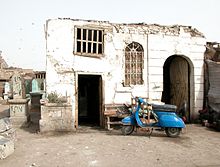 A tomb retrofitted as a residence in the City of the Dead. Cairo's City of the Dead is a centuries old cemetery that has become home to as many as 1 million Egyptians during the last decades.[8]
A tomb retrofitted as a residence in the City of the Dead. Cairo's City of the Dead is a centuries old cemetery that has become home to as many as 1 million Egyptians during the last decades.[8]
Cemetery authorities face a number of tensions in regard to the management of cemeteries.
One issue relates to cost. Traditionally a single payment is made at the time of burial, but the cemetery authority incurs expenses in cemetery maintenance over many decades. Many cemetery authorities find that their accumulated funds are not sufficient for the costs of long-term maintenance. This shortfall in funds for maintenance results in three main options: charge much higher prices for new burials, obtain some other kind of public subsidy, or neglect maintenance. For cemeteries without space for new burials, the options are even more limited. Public attitudes towards subsidies are highly variable. People with family buried in local cemeteries are usually quite concerned about neglect of cemetery maintenance and will usually argue in favour of public subsidy of local cemetery maintenance, whereas other people without connection to the area often argue that public spending comes from their taxes and therefore should be spent on the living in the district rather than being "wasted" on the dead.
Another issue relates to limited amount of land. In many larger towns and cities, the older cemeteries which were initially considered to be large often run out of space for new burials and there is no vacant adjacent land available to extend the cemetery or even land in the same general area to create new cemeteries. New cemeteries are generally established on the periphery of towns and cities, where large tracts of land are still available. However, people often wish to be buried in the same cemetery as other relatives, creating pressure to find more space in existing cemeteries and are not interested in being buried in new cemeteries with which there is no sense of connection to their family.
A third issue is the maintenance of monuments and headstones, which are generally the responsibility of families, but often become neglected over time. Decay and damage through vandalism or cemetery maintenance practices can render monuments and headstones either unsafe or at least unsightly. On the other hand, some families do not forget the grave but constantly visit, leaving behind flowers, plants, and other decorative items that create their own maintenance problem.
Re-use of graves
 Prague's Old Jewish cemetery is the last resting place for more than 100,000 people which had been buried here since the 15th century.
Prague's Old Jewish cemetery is the last resting place for more than 100,000 people which had been buried here since the 15th century.
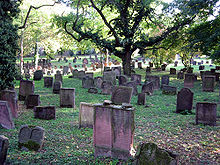 Jewish cemetery "Heiliger Sand" in Worms, Germany
Jewish cemetery "Heiliger Sand" in Worms, Germany
All of these issues tend to put pressure on the re-use of grave sites within cemeteries. The re-use of graves already used for burial can cause considerable upset to family members. Although the authorities might declare that the grave is sufficiently old that there will be no human remains still present, nonetheless many people regard the re-use of graves (particularly their family's graves) as a desecration. Also re-use of a used grave involves the removal of any monuments and headstones, which may cause further distress to families (although families will typically be allowed to take away the monuments and headstones if they wish).
On the other hand, cemetery authorities are well aware that many old graves are forgotten and not visited and that their re-use will not cause distress to anyone. However, there may be some older graves in acemetery for whom there are local and vocal descendants who will mount a public campaign against re-use. One pragmatic strategy is to publicly announce plans to re-use older graves and invite families to respond if they are willing or not. Re-use then only occurs where there are no objections allowing the "forgotten" graves to be re-used. Sometimes the cemetery authorities request a further payment to avoid re-use of a grave, but often this backfires politically.
A practical problem with regard to contacting families is that the original person who organised a burial may themselves also be dead and buried and locating living family members many decades later is virtually impossible (or at least prohibitively expensive). Therefore communication about re-use in local cemeteries tends to occur only through in local publications, which often do not reach family members living further afield who may only become aware of the re-use of the grave after the event (and after the removal and destruction of monuments and headstones).
Some cemeteries did foresee the need for re-use and included in their original terms and conditions a limited tenure on a grave site and most new cemeteries follow this practice, having seen the problems faced by older cemeteries. However, even when the cemetery has the legal right to re-use a grave, strong public opinion often forces the authorities to back down on that re-use. Also, even when cemeteries have a limited tenure provision in place, often funding shortages force them to contemplate re-use earlier than the original arrangements provided for.
Another type of grave site that must be considered for re-use are those that have never been used (but have been purchased at some time for future use). In principle it would seem easier to re-use such grave sites as there can be no claims of desecration, but often this is made more complicated by the legal rights to be buried obtained by the pre-purchase, as any limited tenure clause only takes effect after there has been a burial. Again, cemetery authorities suspect that in many cases the holders of these burial rights are probably deceased and that nobody will exercise that burial right, but again some families are aware of the burial rights they possess and do intend to exercise them as and when family members die. Again the difficulty of being unable to locate the holders of these burial rights complicates the re-use of those graves.
 Cemetery excavations, like this one in Madrid, can alleviate overcrowding.
Cemetery excavations, like this one in Madrid, can alleviate overcrowding.
As historic cemeteries begin to reach their capacity for full burials, alternative memorialization, such as collective memorials for cremated individuals, is becoming more common. Different cultures have different attitudes to destruction of cemeteries and use of the land for construction. In some countries it is considered normal to destroy the graves, while in others the graves are traditionally respected for a century or more. In many cases, after a suitable period of time has elapsed, the headstones are removed and the now former cemetery is converted to a recreational park or construction site. A more recent trend, particularly in South American cities, involves constructing high-rise buildings to house graves.[9]
Cemeteries in the United States may be relocated if the land is required for other reasons. For instance, many cemeteries in the southeastern United States were relocated by the Tennessee Valley Authority from areas about to be flooded by dam construction.[10] Cemeteries may also be moved so that the land can be reused for transportation structures,[11][12] public buildings,[13] or even private development.[14] Cemetery relocation is not necessarily possible in other parts of the world; in Alberta, Canada, for instance, the Cemetery Act expressly forbids the relocation of cemeteries or the mass exhumation of marked graves for any reason whatsoever.[15] This has caused significant problems in the provision of transportation services to the southern half of the City of Calgary, as the main southbound road connecting the south end of the city with downtown threads through a series of cemeteries founded in the 1930s. The light rail transit line running to the south end eventually had to be built directly under the road.
Maintenance and mourning
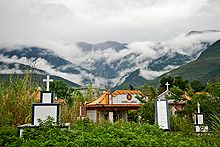 A roadside cemetery in Hualien, Taiwan
A roadside cemetery in Hualien, Taiwan
 A belltower at Forrest Home Cemetery, in Fifield, Wisconsin, USA. Tolling bells during funerals has been customary in some places around the world.
A belltower at Forrest Home Cemetery, in Fifield, Wisconsin, USA. Tolling bells during funerals has been customary in some places around the world.
Cemetery authorities also face tension between the competing demands of efficient maintenance with the needs of mourners.
Labour costs in particular have risen substantially and so finding low-cost maintenance methods (meaning low-labour maintenance methods) is increasingly important. However, as discussed above, the use of large mowers and string trimmers might be efficient but often cannot be used in cemeteries because they physically are too large to fit between graves or because they can damage the monuments and headstones. In this regard, older cemeteries designed at a time of relatively low-cost labour and limited automation tend to present the greatest difficulties for maintenance.
On the other hand, newer cemeteries might be designed to be more efficiently maintained with lower labour through the increased use of equipment, e.g. lawn cemeteries where the maintenance can be performed with a ride-on mower or lawn tractor. However, efficient maintenance of newer graves is often frustrated by the actions of mourners who often place flowers and other objects on graves. These objects often require manual intervention; in some cases objects will be picked up and returned after maintenance, in other cases (e.g. dead flowers) they will be disposed of.
Again, although cemetery authorities try to prohibit the quantity and nature of objects placed on graves (a common restriction is to allow only fresh flowers, not in a vase or pot), but mourning families might ignore any such regulations and become very upset if other objects are removed. In particular, in an era in which the death of children is now relatively uncommon, some parents create quite large shrines at their child's grave, decorating them with toys, wind chimes, statues of angels and cherubs, etc. as a manifestation of their grief, adding items to the pile of objects on the grave progressively over time. Cemetery authorities have to try to deal with such situations sensitively, as strong emotions are involved. However, as well as their own maintenance problems with such "shrines", families with graves in the surrounding area often complain to cemetery authorities about the "mess", as they believe it detracts from the dignity of their family's graves. It is difficult to find a solution that makes everyone happy.
Unusual cemeteries
- The Merry Cemetery in Săpânţa, northern Romania.
- The Cross Bones, a disused burial ground in Southwark, London for prostitutes
- The British Cemetery in Madrid, a cemetery for Protestants and Spanish suicides.
- The Manila Chinese Cemetery in the Philippines has richly decorated mausoleums.
- The Neptune Memorial Reef is a burial ground where the remains of cremated bodies are stored. Due to the location underwater, the burial ground does not take up any otherwise usable space.
Cemeteries for pets
Main article: Pet cemeteryThe Cimetière des Chiens in Asnières-sur-Seine in Paris is an elaborate pet cemetery believed[by whom?] to be the first zoological necropolis in the world.[citation needed]
Cemeteries and superstition
In many countries, cemeteries are places believed to hold both superstition and legend character, being used, usually at nighttimes, as an altar in black magic ceremonies or similarly clandestine happenings, such as devil worshipping, grave-robbing (gold teeth and jewelry are preferred), thrilling sex encounters or drug and alcohol abuse not related to the cemetery aura (see below).
The legend of zombies, as romanticized by Wade Davis in The Serpent and the Rainbow, is not exceptional among cemetery myths, as cemeteries are places where witches and sorcerers get skulls and bones needed for their sinister rituals.
In the Afro-Brazilian urban mythos (like Umbanda), there is a character loosely related to cemeteries and its aura: the Zé Pilintra (in fact, Zé Pilintra is more related to bohemianism and night life than with cemeteries, where the reigning entity is Exu Caveira or Exu Cemitério, similar to Voodoo Baron Samedi).
See also
- Corpse road
- Prison cemetery
- Lists of cemeteries by country
Other types of burial places
- Catacomb
- Churchyard
- Columbarium
- Crypt
- Graveyard
- Mass grave
- Necropolis
- Ossuary
- Tomb
- Tumulus
- Unmarked grave
- War Grave
Regional variations of burial places and practices
- Skull and crossbones (Spanish cemetery)
Specific types of burial places
- Mausoleum
- Megalithic tomb
- Natural burial
- Potter's Field
- Reliquary
- Sepulchre
- Shaft and chamber tomb
- Stupa
- Stone ship
- Tomb of the Unknown Soldier
Removal of remains from cemeteries
- Exhumation
- Grave robbing
- Resurrectionists
Businesses and professions for cemeteries
- Funeral home
- Gravedigger
- Morgue
- Stonemason
- Undertaker
Public holidays and traditions in relation to cemeteries
- All Souls' Day
- Day of the Dead
- Memorial Day
- National day of mourning
- Qingming Festival
- Saturday of Souls
- Bon Festival
Further aids to find cemetery locations or names of those buried
Notes
- ^ Oxford English Dictionary, 2nd Edition 1989, online edition
- ^ "Paris' Secret Underworld". CBS News. September 27, 2004
- ^ Hala Mundhir Fattah; Frank Caso (2009). A brief history of Iraq. Infobase Publishing. p. 140. ISBN 9780816057672. http://books.google.com/books?id=Q_-hrXU-mWYC&pg=PA140. Retrieved 18 October 2010.
- ^ Michael Dumper; Bruce E. Stanley (2007). Cities of the Middle East and North Africa: a historical encyclopedia. ABC-CLIO. p. 269. ISBN 9781576079195. http://books.google.com/books?id=3SapTk5iGDkC&pg=PA269. Retrieved 18 October 2010.
- ^ Lomax, John Nova. "The Seoul of Houston: The Weather Was Not the Strong Point on Long Point." Houston Press. January 30, 2008.
- ^ Alfred Brophy, Grave Matters: The Ancient Rights of the Graveyard
- ^ Local Authorities Cemeteries Order 1977
- ^ "Tomb with a view". BBC News. March 6, 2002
- ^ News: New trend: Cemetery Skyscrapers
- ^ Cemeteries Relocated by TVA. Accessed July 13, 2009.
- ^ "O'Hare Growth May Mean Moving a Cemetery". NPR, November 19, 2005. Accessed July 13, 2009.
- ^ St. Johannes Cemetery Relocation. Accessed July 13, 2009.
- ^ "Remains in 19th century graves downtown ID'd as soldiers". The Tucson Citizen, April 17, 2009. Accessed July 13, 2009.
- ^ "Cemetery Relocation Battle Ongoing". Platte County Citizen, July 4, 2007. Accessed July 13, 2009.
- ^ Cemetery Act of Alberta. Accessed July 13, 2009.
References
- Colvin, Howard. Architecture and the After-Life. New Haven: Yale University Press, 1991.
- Curl, James Stevens. Death and Architecture. Gloucestershire: Sutton, 2002.
- Etlin, Richard A. The Architecture of Death: the transformation of the cemetery in eighteenth-century Paris. Cambridge, MA: MIT Press, 1984.
- Grossman, Janet Burnett. Greek Funerary Sculpture. Catalogue of the Collection at the Getty Villa. Los Angeles: J. Paul Getty Museum, 2001.
- Salisbury, Mike. From My Death May Life Come Forth. A Feasibility Study of the Woodland Cemetery in Canada Earthartist.com
- Worpole, Ken. Last Landscapes: the architecture of the cemetery in the West, Reaktion Books, London, 2003
External links
- Cemeteries at the Open Directory Project
Death and related topics In medicine Abortion · Autopsy · Brain death · Clinical death · End-of-life care · Euthanasia · Lazarus syndrome · Terminal illness · Mortal woundLists Causes of death by rate · Expressions related to death · Natural disasters · People by cause of death · Premature obituaries · Preventable causes of death · Notable deaths in 2007 · Notable deaths in 2008 · Notable deaths in 2009 · Notable deaths in 2010 · Unusual deathsMortality After death Body: Burial · Coffin birth · Cremation · Cryonics · Decomposition · Disposal · Mummification · Promession · Putrefaction · Resomation
Other: Afterlife · Cemetery · Customs · Death certificate · Funeral · Grief · Intermediate state · Mourning · VigilParanormal Legal Other Death and culture · Death (personification) · Fascination with death · Genocide · Last Rites · Martyr · Moribundity · Sacrifice (Human · Animal) · Suicide · Assisted suicide · Thanatology · War Death Portal
Death PortalReal estate developments Commercial Business park · Office building · Ports and waterfronts · Retail park · Shopping mall / center · Shopping streets and districts · Warehouse DistrictIndustrial Residential Science / Education Municipal Buildings Miscellaneous Brownfield land · Cemetery · Cluster development · Construction · Context theory · Eminent domain · Land use planning · Park · Parking · Playground · Redevelopment · Regional planning · Urban design · Urban planning · ZoningCategories:- Cemeteries
- Death customs
- Planned developments
Wikimedia Foundation. 2010.

